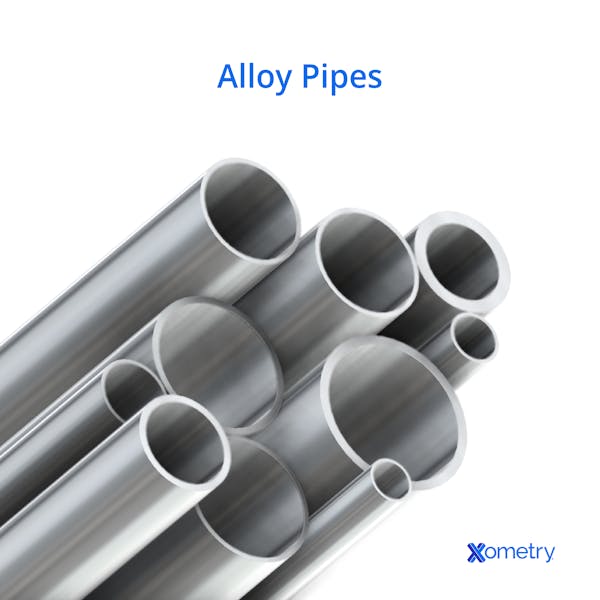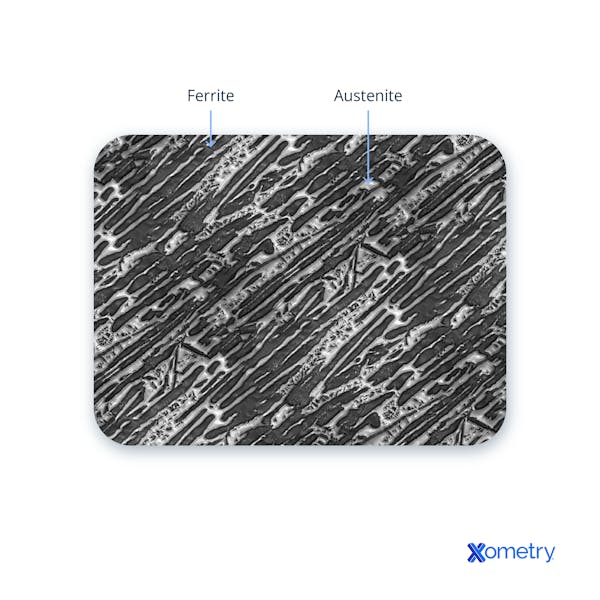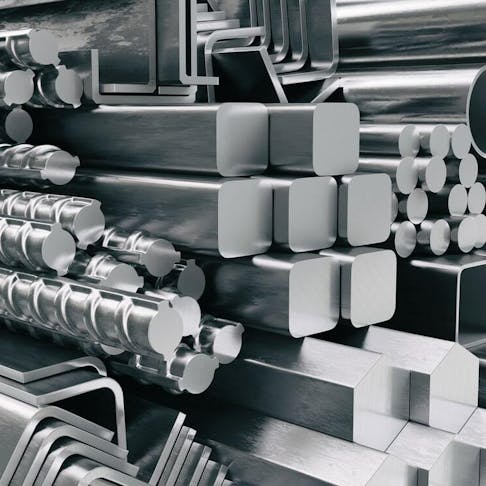Alloy steel and stainless steel are not the same thing, but stainless steel is a type of alloy steel. “Alloy steel” is a term that covers any steel that has at least one more element added to it to give it extra perks, like more strength or durability and change its overall properties. We’ve written up a whole guide on alloy steel if you’d like to know more about it. Basic steel, without any alloying elements, usually consists of iron and some carbon. Aside from these, you might find some chromium, which is added to make it corrosion-resistant, but stainless steel has at least 10.5% chromium.
Stainless steel is extremely popular among Xometry customers, but there are many different grades of it, all with different strengths (and maybe also some weaknesses). Keep reading for more on the different types of alloys and stainless steel and how stainless steel fares compared to the other types of alloys.
What Is Alloy Steel?
Alloy steel is a catch-all category for steel materials that contain one or more alloying elements (a substance added to another material to improve its properties). All basic steel consists of iron and a small amount of carbon. The most common additional alloying element is chromium, which gives steel corrosion-resistant properties. Other elements that can be used to alloy steel include: manganese, molybdenum, nickel, titanium, tungsten, and vanadium. The properties of alloy steel depend on the specific elements that are added to it. For example, chromium increases the hardness, wear resistance, and toughness of steel while manganese increases its ductility, hardenability, and wear resistance.
What Is Stainless Steel?
Stainless steel is a type of alloyed steel that contains at least 10.5% chromium, making it highly resistant to corrosion. The added chromium makes it an ideal material for a wide range of applications, from cookware to medical equipment. Its unique properties make it a popular choice for consumers and businesses alike. It is important to note that there are also different grades of stainless steel, each with its own set of properties.
What Are the Properties of Alloy Steel?
Table 1 highlights the properties of Alloy Steel:
| Physical Properties | Chemical Properties |
|---|---|
Physical Properties High strength-to-weight ratio. | Chemical Properties Contains high levels of chromium, molybdenum, and/or other alloying elements. |
Physical Properties Good corrosion resistance | Chemical Properties The higher levels of alloying elements often allow alloys to be heat-treated to a wide range of hardness levels. |
Physical Properties High strength and durability | |
Physical Properties Resistance to wear | |
Physical Properties Hardness at high temperatures |
Properties of Alloy Steel
| Physical Properties | Chemical Properties |
|---|---|
Physical Properties Resistant to corrosion and staining | Chemical Properties Resistant to bases, acids, and also organic compounds |
Physical Properties Durable | Chemical Properties Composed of iron, chromium, and carbon. Some varieties may include manganese, silicon, nickel, or other elements |
Physical Properties Easy to clean and maintain | |
Physical Properties Non-magnetic | |
Physical Properties High resistance to heat | |
Physical Properties Electrically conductive |
Properties of Stainless Steel
| Type | Description |
|---|---|
Type Low-alloy | Description Only a small amount of additional elements are added to this type of steel to enhance some of its properties, like strength, hardness, or toughness. These could be chromium, nickel, and/or manganese. It’s used when the strength-to-weight ratio is important, like for construction and mining equipment. |
Type High-alloy | Description These have larger amounts of alloying elements to greatly improve the steel’s performance. These include chromium, vanadium, and nickel, which are particularly helpful in ramping up the steel’s hardness and strength. |
Type Tool | Description Tool steels are used for making tools, and will usually have many other elements added to make them extra hard and wear-resistant, even at high temperatures. |
Type Maraging | Description These types of steel are impressively strong and tough. They’re often used in circumstances that require serious strength like aerospace and the military. |
Types of Alloy Steel
The below image shows some pipes made from alloy steel:

| Type | Description |
|---|---|
Type Austenitic | Description This category usually contains a minimum of 16% chromium and 6% nickel (the basic grade 304 is 18% chromium and 8% nickel). Because this type of steel won’t easily corrode, rust, or stain when in contact with water, many Xometry customers use it in chemical plants and food processing equipment. |
Type Ferritic | Description Ferritic stainless steel usually contains between 11% and 27% chromium, and little to no nickel. They’re not the best when it comes to corrosion resistance, especially when compared to austenitic stainless steels, but they exhibit better mechanical properties at elevated temperatures. |
Type Martensitic | Description This type of stainless steel typically contains between 14% and 18% chromium and between 0.2% and 1.2% carbon, which is considered moderate. Like carbon steel, it can be hardened and tempered. |
Type Duplex | Description These have 18–28% chromium, and 3.5–5.5% nickel. They’re more corrosion-resistant than austenitic grades, and less likely to become brittle than martensitic grades. |
Types of Stainless Steel
Here’s what duplex stainless steel looks like:

What Are the Advantages of Alloy Steel Compared to Stainless Steel?
Listed below are the advantages of alloy steel compared to stainless steel:
- Alloy steel is more resistant to wear and tear compared to stainless steel.
- Alloy steels are easier to weld compared to stainless. Though stainless steel is weldable, the process is not easy as other welds.
- Alloy steel is less expensive and can easily be machined compared to standard stainless grades
- Alloy steels are more durable than stainless steel.
Alloy vs. Stainless Steel
What Are the Disadvantages of Alloy Steel Compared to Stainless Steel?
Listed below are the disadvantages of alloy steel compared to stainless steel:
- Alloy steel is less resistant to corrosion compared to Stainless steel. As a result, it requires a protective finish after manufacturing.
- Alloy steel has low strength at high temperatures.
- An alloy steel surface finish is not as good as that of stainless steel.
What Are the Comparisons Between Alloy Steel and Stainless Steel?
Below you’ll find a side-by-side comparison of alloy and stainless steel’s physical and chemical properties.
| Alloy Steel | Alloy Steel | Stainless Steel | Stainless Steel |
|---|---|---|---|
Alloy Steel Physical Properties | Alloy Steel Chemical Properties | Stainless Steel Physical Properties | Stainless Steel Chemical Properties |
Alloy Steel High strength-to-weight ratio | Alloy Steel High levels of chromium, molybdenum, and/or other alloying elements | Stainless Steel Corrosion- and stain-resistant | Stainless Steel Composed of iron, chromium, and carbon, with some varieties including silicon, manganese, and nickel, among others |
Alloy Steel Good corrosion resistance | Alloy Steel Higher alloying element levels can allow the metals to be heat treated to many different hardnesses | Stainless Steel Very durable | Stainless Steel Resistant to bases, acids, and organic compounds |
Alloy Steel Strong and durable | Stainless Steel Electrically conductive | Stainless Steel - | |
Alloy Steel Wear-resistant | Alloy Steel Stainless steel is not magnetic | Stainless Steel Easy to clean/ maintain | Stainless Steel - |
Alloy Steel Stays hard at high temperatures | Alloy Steel It’s highly resistant to heat | Stainless Steel Not magnetic | Stainless Steel - |
Alloy Steel - | Alloy Steel - | Stainless Steel Highly heat-resistant | Stainless Steel - |
Alloy Steel vs. Stainless Steel Physical and Chemical Properties
Now let’s have a look at how each steel type compares in relation to thermal conductivity, tensile strength, and applications:
| Property | Alloy Steel | Stainless Steel |
|---|---|---|
Property Thermal Conductivity | Alloy Steel Around 45 W/(mK) | Stainless Steel 15 W/(mK) |
Property Tensile Strength | Alloy Steel Up to 960 Mpa (more durable than stainless steel) | Stainless Steel Around 621 Mpa |
Property Application | Alloy Steel Mainly construction and manufacturing | Stainless Steel Food and beverage, medical |
Alloy Steel vs. Stainless Steel Thermal Conductivity, Tensile Strength, and Applications
What Are the Mutual Alternatives to Alloy Steel and Stainless Steel?
Some of the mutual alternatives to traditional alloy steel and stainless steel are:
- Titanium Alloys: Titanium alloys are known for their high strength-to-weight ratios. These properties make them an ideal choice for many applications where weight is a concern.
- Aluminum Alloys: Aluminum alloys are often used in applications where strength and weight are both important considerations.
What Are the Similarities Between Alloy Steel and Stainless Steel?
Stainless steel is technically a specific type of alloy steel. Both contain a variety of elements, making them very versatile materials. Many alloys contain chromium, the key element in stainless steel. Chromium-laced steel resists corrosion because the added element forms a protective layer on the surface of the metal. Additionally, stainless, alloy, and all other types of steel are created from iron and carbon. When combined in the right ratio, these elements form a very strong and durable molecular lattice. Finally, stainless steel and most other alloys can be heat-treated to improve their properties making them highly versatile materials that can be customized to suit a wide range of applications.
What Are the Other Comparisons for Stainless Steel Besides Alloy Steel?
Stainless steel is often compared against several other similar materials:
- Carbon Steel: Carbon steel is one of the most common types of steel. It is known for its strength and durability. Carbon steel is also less expensive than stainless steel, making it a popular choice for a variety of applications. The downside is that it rusts.
- Tool Steel: Tool steel is a type of carbon steel that is well-suited for making tools. It is known for its hardness and resistance to wear, a fact that manufacturers exploit for such items as knives, saws, and drill bits.
What Are the Other Comparisons for Alloy Steel Besides Stainless Steel?
Other materials one might choose instead of alloy steel include:
- Aluminum: Aluminum is the most common type of material used in automobile manufacturing. Water does not cause it to corrode the way iron-based metals do. Plus, Aluminum is both lightweight and very strong, making it ideal for car body panels and other structural components.
- Chromium-vanadium: The combination of chromium and vanadium atoms create lattice structures with very favorable strength-to-weight ratios, making it ideal for applications that require a strong material that is still lightweight. Because of its strength, it is often used in the manufacture of cutting tools.
How Xometry Can Help
Xometry provides a wide range of manufacturing capabilities and other value-added services for all your prototyping and production needs. If you need any information or services for alloy steel, stainless steel, or any other metal, feel free to reach out to one of our representatives, or get a quick no-obligation quote.
Disclaimer
The content appearing on this webpage is for informational purposes only. Xometry makes no representation or warranty of any kind, be it expressed or implied, as to the accuracy, completeness, or validity of the information. Any performance parameters, geometric tolerances, specific design features, quality and types of materials, or processes should not be inferred to represent what will be delivered by third-party suppliers or manufacturers through Xometry’s network. Buyers seeking quotes for parts are responsible for defining the specific requirements for those parts. Please refer to our terms and conditions for more information.


